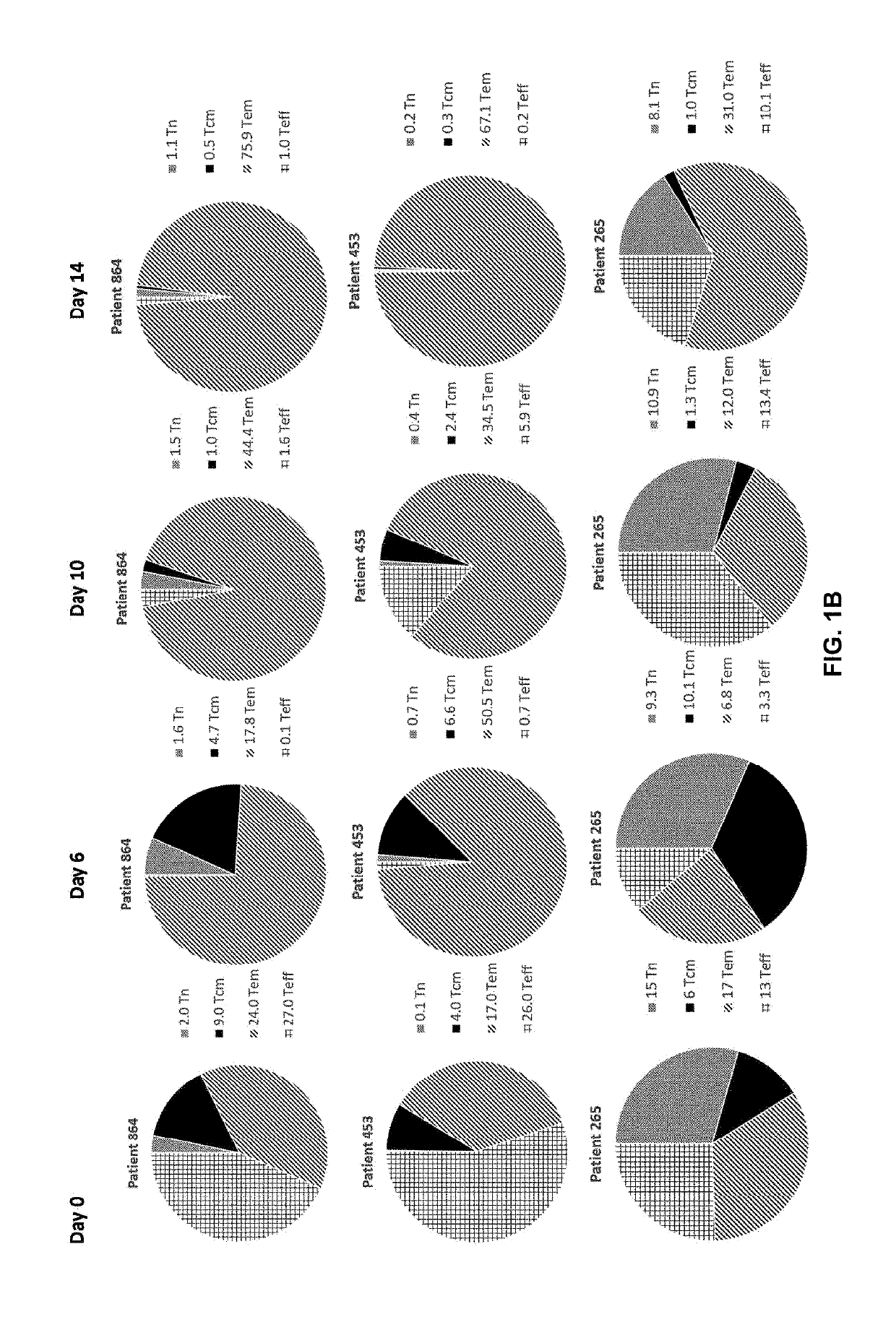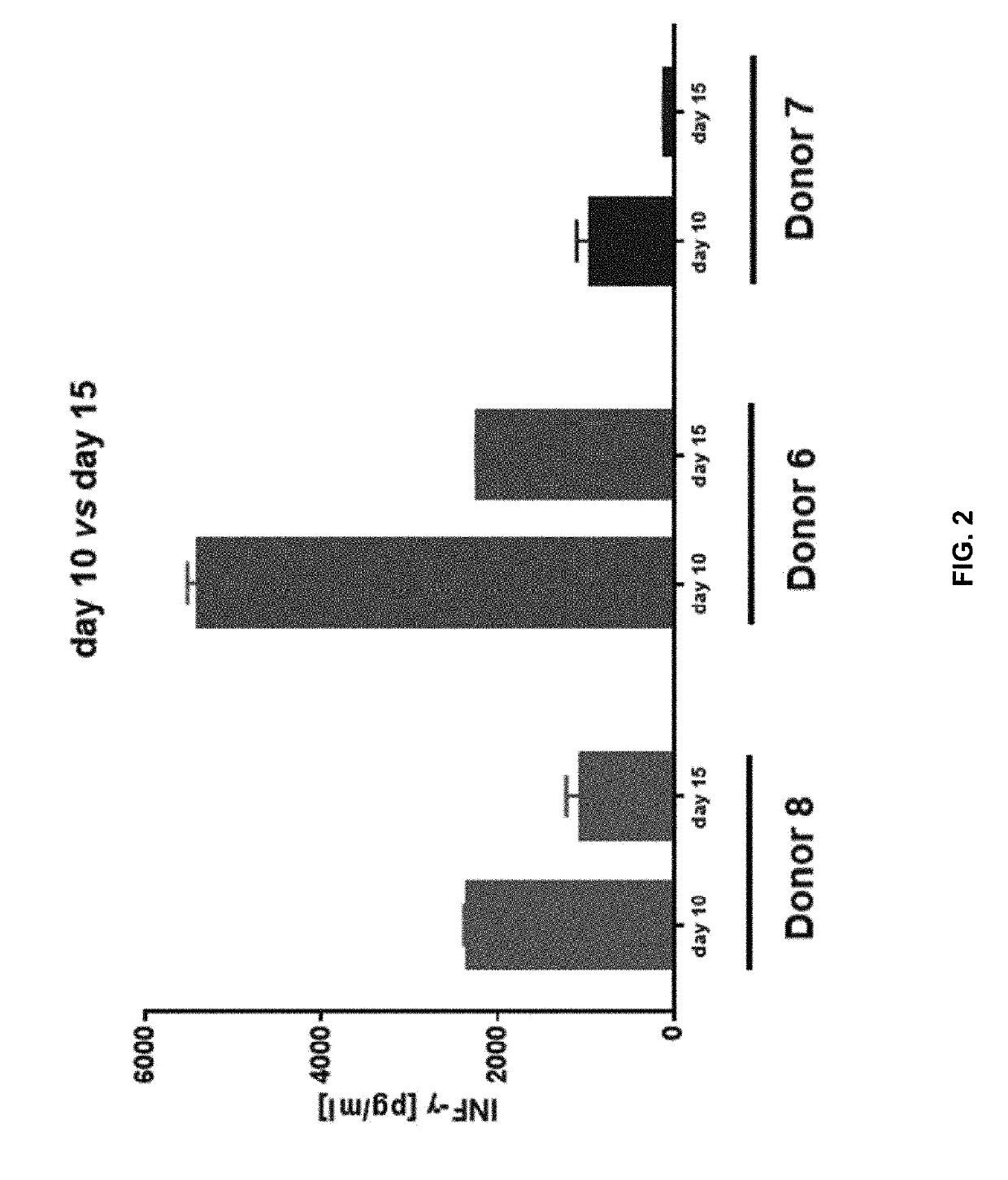Methods for manufacturing t cells
a technology of t cells and manufacturing methods, which is applied in the direction of genetically modified cells, drug compositions, peptides, etc., can solve the problems of difficult to obtain a suitable number of autologous cells in heavily pretreated patients, and the promise of treatment approaches is hardly economically feasible, so as to reduce resting time and reduce resting time
- Summary
- Abstract
- Description
- Claims
- Application Information
AI Technical Summary
Benefits of technology
Problems solved by technology
Method used
Image
Examples
example 1
[0185]Autologous T Cell Manufacturing Process
[0186]Adoptive cell transfer of purified naïve (Tn), stem cell memory (Tscm), and central memory (Tcm) T cell subsets causes superior tumor regression compared with transfer of the more-differentiated effector memory (Tem) and effector (Teff) T cells. Traditional manufacturing process for an engineered T cell product may take 10-15 days long. However, a process longer than about 12 days, e.g., 14 days, may result in reduced potency of the cells, e.g., fewer more-effective Tn, Tscm, and Tcm T cell subsets and more less-effective Tem and Teff T cell subsets. For example, FIG. 1A shows prolonging ex vivo culturing of T cells, e.g., 14 days, from two healthy donors, e.g., donor 6 and donor 8, in which the desirable Tcm T cell subsets were reduced from that cultured for 0, 6, or 10 days. On the other hand, the more differentiated and less persistent Tem T cell subsets were increased from that cultured for 0, 6, or 10 days. FIG. 1B shows prolon...
example 2
[0213]Determine Optimal Duration of T Cell Activation for the Improvement of Transduction Efficiency with Lentiviral Construct
[0214]PBMC from healthy donors were activated using anti-CD3 and anti-CD28 antibodies for different time intervals in preparation for transduction. Activated T cells from PBMC were treated with concentrated supernatants generated using different lentiviral constructs expressing TAA targeting R7P1 D5 TCR. Transduced cells were expanded in the presence of IL-7 and IL-15. The products were compared based on R7P1 D5 TCR transgene expression as determined by flow cytometry using specific dextramer / tetramer.
[0215]Representative Materials and Methods
SuppliesManufacturerCatalog #TexMACS mediaMiltenyi Biotec130-097-196Human AB SerumGemini100-512PBS / EDTALonzaBE02-017FIL-7Peprotech200-07IL-15Peprotech200-15Anti-CD3 antibodyEbioscience16-0037-85Anti-CD28 antibodyEbioscience16-0289-8524-well non-tissue culture platesCo-star3738G-Rex 24-well plateWilson Wolf80192M15 mL Con...
example 3
[0232]Like all bioprocesses, scaling up of T cell manufacturing is a challenging part of the process development. Maintaining T cell function and quality to preserve product efficacy is of prime importance through all stages of scale up. For autologous T cell manufacturing process, the present inventors identified the critical steps and divided the scale-up into two parts: scale up of activation may be carried out on a non-tissue culture surface and scale up of transduction and expansion may be carried out in a G-Rex device.
[0233]Although beads or soluble antibodies present simpler methods to activate cells that are easily scalable, autologous T cell manufacturing processes which use immobilized antibodies on a non-tissue culture surface (24-well plate) for activation yielded the best transduction and expansion rates with the lentivirus. However, harvesting activated cells from multiple 24-well non-tissue culture antibody coated plates posed to be a laborious, time-consuming step th...
PUM
 Login to View More
Login to View More Abstract
Description
Claims
Application Information
 Login to View More
Login to View More - R&D
- Intellectual Property
- Life Sciences
- Materials
- Tech Scout
- Unparalleled Data Quality
- Higher Quality Content
- 60% Fewer Hallucinations
Browse by: Latest US Patents, China's latest patents, Technical Efficacy Thesaurus, Application Domain, Technology Topic, Popular Technical Reports.
© 2025 PatSnap. All rights reserved.Legal|Privacy policy|Modern Slavery Act Transparency Statement|Sitemap|About US| Contact US: help@patsnap.com



